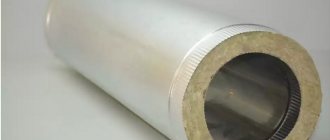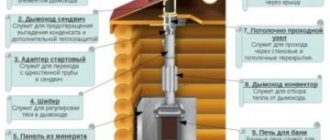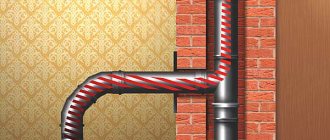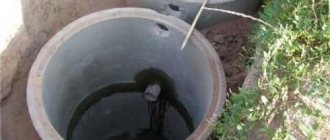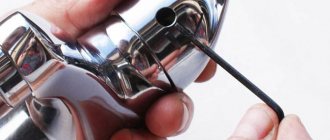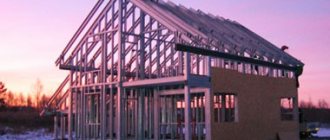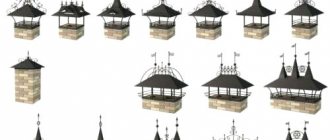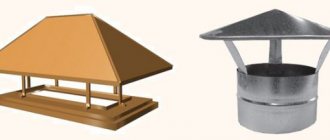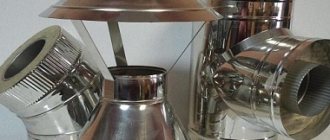Andrey
2046 0 0
Andrey November 1, 2017 Specialization: facade finishing, interior finishing, construction of dachas, garages. Experience of an amateur gardener and gardener. We also have experience in repairing cars and motorcycles. Hobbies: playing the guitar and many other things that I don’t have time for :)
When installing a chimney on the roof, it is necessary to solve a number of problems, such as ensuring effective draft, sealing the passage of the chimney through the roofing pie and ensuring fire safety. In fact, there is no need to rack your brains over these problems, since ready-made solutions are already available. Actually, I suggest you familiarize yourself with them.
The passage of the chimney through the roof must be fireproof and sealed
In what cases is it necessary to extend the chimney?
- The pipe is less than five meters high
- The pipe head (visible part on the roof) is located in the wind pressure zone
- The brick shaft consists of several channels, including smoke and ventilation
Chimney height
According to regulatory documents and the laws of physics, normal vacuum in a chimney begins when the chimney height is more than 5 meters. This does not mean that all heating devices with lower chimney pipes will not work correctly, i.e. smoke. But if your heating device smokes and the pipe is below five meters, this is one of the reasons why smoke occurs. Let me emphasize one of the reasons! There can be many more reasons, and not all of them are related to the height of the chimney. A professional chimney-stove specialist can determine all the reasons, but now we will only talk about the height of the chimney.
Wind pressure zone
The wind support zone is a part of the roof of a building in which the playful wind, receiving turbulence from the structures above or the ridge of the roof, blows downwards, including blowing into the chimney located in this zone.
Pay attention to the picture, if your chimney pipe is located below the dotted lines, then the pipe needs to be extended.
Brick mine with several channels
When a brick shaft has several channels, for example from a gas boiler, a ventilation duct from the boiler room, ventilation ducts from the kitchen and bathroom, warm and humid air currents mix and settle on the inner surface of the common umbrella, turning into icicles and ice growths.
In the absence of supply ventilation, the formation of reverse draft should not be ruled out when one of the channels begins to blow in the opposite direction. If this happens, exhaust fumes from the gas boiler begin to enter the room, which means you and your family members are breathing carbon monoxide.
Cross section of a chimney with several channels
In this case, one channel from a heating device, for example from a gas boiler, is expanded.
Principle of operation
Before lighting the fireplace, the smoke exhauster is turned on at maximum speed to displace cold air.
After lighting the fireplace, it is recommended to select a rotation speed sufficient to remove smoke.
The smoke exhaust fan is located horizontally on the roof or chimney. But it is important to consider the direction of the air flow. It is also necessary to ensure unobstructed access for equipment maintenance.
If you need a fan for a barbecue or fireplace, products from the First Passage company are at your service. All presented products have undergone appropriate testing and meet existing quality standards. We offer each client affordable prices and high-quality service. If you need a fan for a barbecue or fireplace, products from the First Passage company are at your service. All presented products have undergone appropriate testing and meet existing quality standards. We offer each client affordable prices and high-quality service.
Chimney extension technology
If the chimneys are made of modern materials, stainless steel (double-wall sandwich pipes) or ceramics, for example Schiedel Uni, the chimney extension should be carried out with pipes from these manufacturers, strictly following the work technology recommended by the manufacturers.
Brick chimneys are built up either with brick or stainless steel pipes. Stainless steel is used to extend chimney pipes or one of the channels of a brick shaft to remove combustion products from a heating device (stove, fireplace, gas boiler).
Adapter from brickwork to stainless pipe
When switching from masonry to stainless steel, there are two main issues to consider:
- The cross-section of the chimney must not be narrowed. To do this, it is necessary to calculate the internal cross-sectional area of the existing pipe, multiplying the lengths of the internal surface of the pipe by each other and select the diameter of the round pipe corresponding to the area, calculating it using the formula πR².
- Increasing the height of the chimney should be done with insulated, double-walled pipe sections. Single-wall pipes freeze in cold weather and air pockets form in them, preventing the startup of boilers and the ignition of stoves and fireplaces.
When the pipe height increases above 2 meters, additional fastening elements should be provided.
Secrets of stove-makers' mastery
- Before laying, the brick must be soaked - lowered into water and wait until the violent eruption of air bubbles stops. Wet ceramic blocks adhere more firmly to the mortar.
- To split and chisel bricks, use a grinder with a diamond disc for stone.
- When laying in the attic, hang a plumb line on the rafters, between the future pipe and the workplace. This will save you from having to touch it to check. To control the verticality of the angle, it is enough to change the position of the head.
Do not forget that a chimney in a private home is not only a convenience, but also a technical device that requires proper operation and maintenance. Clean it from soot, inspect it for cracks, heat the stove or fireplace with dry wood and it will serve well for many years.
Effective ways to increase chimney draft
Designing a chimney is complex and responsible, on the correct execution of which the efficiency and safety of using the heating device depends. No heat generator is capable of functioning normally without a pipe that removes smoke from the room. Smoke is a mixture of gases containing residual products of fuel combustion. The appearance of smoke inside a heated room is a sure sign of an incorrect design of the chimney system, which entails the risk of fire and carbon monoxide poisoning. This article will tell you what backdraft in a chimney is and how to prevent its occurrence.
Measurement methods
If you doubt that the chimney draft of a stove, fireplace or heating boiler is sufficient, you need to check it. The easiest way to dispel doubts is to check it yourself using an anemometer. If the device shows a draft of 10-20 Pa, then it is considered normal . The problem with this method is the low measurement accuracy of inexpensive anemometers; if the draft is less than 1 Pa, then they will show that there is no draft. More accurate professional instruments are expensive; they are used by stove makers.
If you don’t have an anemometer, use one of the popular methods for determining the draft force of a chimney:
- By the smoke. The most obvious sign that there is no draft is the presence of even slight smoke inside the room; a large amount of smoke indicates a high risk of fire and carbon monoxide poisoning.
Note! The draft inside the chimney duct is created due to the difference in pressure outside and inside the room. In a heated room, the temperature is higher than outside, so there is more pressure there. Heated air, supported from below by colder air, is squeezed into a zone with lower pressure, that is, into the atmosphere. If you take measurements in the summer, when the temperature difference between inside and outside is minimal, you will get a lower result than in winter.
Elastic penetration
Most often in private construction they are faced with the installation of round metal pipes. To ensure the tightness of the passage, a special device is used - an elastic penetration. This is a product made of high-strength silicone or rubber, shaped like a funnel with a wide flange in the form of a square or circle, called an apron.
Installation diagram of elastic penetration
Elastic penetration on a metal chain
When purchasing an elastic penetration, they are guided by the diameter of the pipe and the color of the roofing material. Universal models, in the form of a stepped pyramid, are suitable for any size; adjustment is carried out by trimming the penetration to the desired level. Installing an elastic apron on the roof is very simple, you need to place it on the chimney passage, apply a metal circle with holes for fasteners, treat the joint with fire-resistant sealant and secure it with a screwdriver. For roofs with steep slopes, a special type of plastic penetrations with a specified flange mounting angle is used.
Causes of malfunctions
After making sure that there is not a sufficient level of draft inside the chimney system, you need to determine and eliminate the possible cause of this defect. Experienced craftsmen claim that the most common causes of failures in smoke exhaust ducts are:
- Design error. The choice of chimney pipe should be made based on the volume of the firebox. If the diameter is less than the calculated parameter, the weak one will not allow smoke to escape from the room.
- Insufficient pipe length. A pipe length of less than 5 m does not provide a significant difference between the pressure indoors and outdoors, which results in weak draft.
- Incorrect placement of the chimney pipe. I advise stove technicians to lay the chimney vertically, as narrow turns trap smoke inside the chimney, reducing draft.
- Long horizontal sections. If, when laying a chimney, you cannot avoid horizontal sections, then make sure that their length is no more than 100 cm. Otherwise, it will need an amplifier.
The first step when detecting problems in the chimney system is to dismiss the most obvious causes of insufficient draft. When inspecting, make sure that the connections of all pipe segments are tight and that there are no soot blockages. Check that no moisture has entered the smoke exhaust ducts and that the atmospheric pressure is normal.
How to make a pipe passage through the ceiling and roof: a step-by-step guide from the master
The most common type of chimney for a bathhouse is made from sandwich pipes. It is his installation that I will consider. The sandwich is very easy to install; elements for pipes of any configuration are available for sale. Stainless steel chimneys last for several decades; the calculated thickness of the insulation ensures good draft.
Step 1
Initial installation stage:
- connection to the outlet pipe of the tee;
- connection of a horizontal or vertical section without insulation, transition from an uninsulated pipe section to an insulated one;
- installation from below of an element with revision and a container for condensate drainage.
Ways to increase traction
If the draft force is in the chimney duct of the heating device, eliminating this defect is not always easy. Experienced stove makers use the following methods and methods to increase it:
- The first thing to do if you suspect insufficient draft in the chimney is to clean the pipe. To do this, call a chimney sweep or remove soot deposits from the inner surface of the chimney with your own hands using a metal stove brush.
- A significant increase in the power of the chimney can be achieved by increasing the height of the chimney above the roof surface by adding several additional segments. Using the same method, the chimney is removed from the zone of wind pressure from a ridge or higher building.
If you were unable to find a solution to the problem of lack of draft inside the smoke exhaust duct on your own, seek advice from an experienced stove maker who will tell you what to do and correct the defect in the most rational way.
Preventing the condition of the chimney
To avoid the need to use means of forced exhaust of a chimney made of heat-resistant material, it is necessary to use preventive means to maintain it in working condition.
Since the main reason for reducing the intensity of flue gas extraction is the reduction in the passage of the pipe by soot accumulated on the walls, we will consider means of combating this phenomenon.
These methods could be:
The frequency of use of high-temperature products should be regular, at least twice a week, so that soot does not have time to accumulate. Otherwise, you can cause a serious fire, since the soot burns and releases a very large amount of heat.
In addition to those listed, there are many anti-soot agents on the market for both chemical and thermal decomposition of soot. The use of preventive measures can eliminate the need for forced measures to improve the exhaust hood on the chimney.
How to increase draft in ventilation: a review of methods and devices for increasing draft
Clean air is vital for any person, and it is completely natural to want to use technological advances and the experience of craftsmen to build an ideal ventilation system in your home. And as a result, every owner is faced with the question of how to increase ventilation draft so that polluted exhaust air easily gives way to fresh flows.
If you have problems with ventilation or are just building a new house, use the advice of our experts and the list of draft accelerators they prepared, and the ventilation in your home will be normalized.
What is ventilation?
People, while in their apartment, cook, clean, wash and simply breathe during the day, thereby saturating the air with excess moisture and odors, polluting it with carbon dioxide. During the process of replacing air masses, all this happens unnoticed with normally functioning ventilation, but results in considerable problems in the event of a failure of the air exchange system.
Without proper ventilation, the corners of the apartment become moldy, there is dampness, condensation on the windows, and a musty smell.
You can check the performance of the channel in a simple and effective way: by deflecting or moving a small piece of paper near the ventilation grill, or by the absence of dirt and dust on it if the ceiling and walls are smoked.
Air exchange and types of ventilation
Air exchange is the directed movement of air masses of different temperatures, which occurs due to draft in the exhaust ducts.
Air movement is carried out according to two elementary rules:
- air moves to an area of lower pressure;
- heated air moves upward.
Traditional natural ventilation is becoming less and less effective over time due to the different nature of the materials used in the construction of modern buildings.
Instead of “breathing” wood and brick, houses are dominated by foam concrete, artificial thermal insulation and finishing materials, soundproofing doors and metal-plastic windows. As a result, air is not able to circulate freely and easily through the rooms; therefore, multifunctional ventilation complexes took the palm.
In the supply part, in the absence of infiltration, it is possible to install supply valves and a fan. Doors with bars will help to achieve flow; exhaust devices are necessary in bathrooms and kitchens.
In addition to conventional classical ventilation, mechanical air exchange methods are used for full functioning. The most popular and in demand method of arranging ventilation is considered to be a supply and exhaust system, which not only removes used air, but also prepares incoming air (filters, warms or cools, cleans).
Factors influencing traction force
Regardless of the type of device, the main indicator of the effective operation of the system is traction, the intensity of which depends on a number of reasons.
The directional movement of air masses from the room to the outside naturally depends on uncontrolled weather conditions:
- numerical difference in temperature indicators in the room and at the outlet of the channel (in cold weather the draft increases, and in the summer it disappears);
- atmospheric pressure;
- wind direction and speed.
However, there are ways to influence the strength and speed of air currents.
Therefore, in the process of planning a ventilation system or its reconstruction, it is necessary to pay due attention to the following factors:
- height of the outlet pipe on the roof;
- dimensions and internal surface of the ventilation duct;
- channel layout;
- installation of deflector type devices.
As everyone knows, air gravity in air ducts occurs due to a difference in temperature and pressure at the inlet and outlet. For the stability of this process, it makes sense to maintain the desired temperature by placing ventilation pipes at least in the interior space, and ideally next to warm pipes or insulating them.
In addition, there are a number of rules and requirements for the height of placement. The used air must leave the building above the roof, and the height of the exhaust pipe above the roof cannot be less than half a meter.
The resulting difference in height leads to normalization of the ventilation system and increased draft, which is lacking for residents of the top floors of multi-story buildings with a flat roof - they have problems with air exchange.
For traction force, not only the height of the ventilation duct, but also the direction of its laying is of great importance. It is advisable to place it only vertically with the least number of turns (each one reduces traction by 10%).
If possible, a pipe of the same diameter is used along the entire length; if a connection is necessary, the deviation angle is no more than 30 degrees.
The most popular type of ventilation pipe is considered to be a round rigid air duct; due to lower resistance and good air flow intensity, it is ahead of the economical rectangular and flexible corrugated ones.
When choosing parameters, it is recommended to use pipes with a cross-section of at least 16 sq. cm - if made of stainless steel, and with a channel side of at least 10 cm, but most often a size of 14 cm is used.
Increasing the pipe parameters will entail increased traction, therefore, it is more profitable to use the maximum possible dimensions of diameter and length. In cases where it is not possible to install channels with the same length, they resort to installing ventilation grilles in all rooms of the building.
Using a deflector for ventilation
One of the most effective ways to solve ventilation problems is the installation of draft accelerators for ventilation, for example, deflectors. Unlike the methods discussed above for increasing traction, which are more convenient to use during construction or major repairs, installation of a device such as a deflector can be done at any convenient time.
In addition, the installation allows you to neutralize the consequences of such difficult-to-correct actions as insufficient channel diameter, small height, difficult weather conditions or poor location.
The deflector is mounted on the outlet ventilation duct above the roof of the building; its size depends on the amount of air emitted and the diameter of the air duct. Available in standard sizes, many manufacturers work to order according to individual parameters.
The most common manufacturing materials are plastic and metals - aluminum, galvanized and stainless steel.
Plastic deflectors look much more advantageous in appearance due to their varied designs and colors; they are also much cheaper, but you need to take into account that their service life is short due to their instability to high temperatures.
The usual model of a ventilation deflector consists of a pipe, a diffuser and a cap with or without a return cylinder. Installation of the device is simple; you can install a standard deflector yourself easily and simply.
The lower pipe, the diffuser and the cap are alternately attached to the pipe head; connections are made with clamps, bolts and brackets. It is important that the cap is larger than the diameter of the diffuser to protect against slanting rain.
The mechanism of action of the deflector is based on the elementary rules of physics. The wind, entering the device body, is cut through by a diffuser, a rarefied zone appears and air masses, becoming active, rush from the ventilation duct into the area of low pressure.
In addition to its main function, the deflector also solves a number of other problems:
- protection from debris;
- reducing the influence of negative natural conditions;
- increasing the efficiency of the ventilation system by 20%;
- the risk of backdraft is reduced.
They choose a deflector based on design and price, usually choosing well-known, well-proven models - TsAGI, Grigorovich, Astato, weather vane, H-shaped model.
Such a simple device as a deflector will help cope with a common ventilation problem - weak exhaust draft. However, we should not forget that the exhaust will not work fully without a supply ventilation system.
And when checking the exit to the roof of the exhaust shafts, it is necessary to remember about the intake grilles to allow fresh air masses to enter. Their height above the ground must be at least 2 meters.
How much will it cost
Over the course of three centuries, the brick chimney on the roof has become a visual constant. And a building with such a finish looks, according to subjective assessments, much more attractive.
All that remains is to determine how much compliance with the canons will cost you. If you involve third-party craftsmen, the cost of the work will also be added to the cost of the brick. And she's quite big. In St. Petersburg and the region, for example, laying one brick will cost from 50 to 90 rubles.
The solution, if you prepare it yourself, is free.
Five kilograms of ready-made masonry mixture cost 60-70 rubles. One package is enough for 10-15 rows of pipes with a cross-section of 125 by 250 mm (sixes).
Let's compare the cost of a meter of a metal sandwich pipe with a diameter of 250 mm and a brick pipe with a cross-section of 250 by 250 mm. Just the kind that can be used for installing fireplace chimneys.
| Brick (at a price of 15 rubles per piece) | Masonry mixture | Master's work | Total, rubles | |
| Brick chimney | 900 rubles | 70 rubles | 3000 rubles | 3970 |
| Metal sandwich pipe | – | – | – | 3800 |
As you can see, the prices are almost the same. Of course, it’s worth adding the cost of laying the fluff, the otter and the head. But, given the better performance characteristics of brick pipes - lack of corrosion, greater heat resistance, it makes sense to spend money on such a purchase. And if you are planning to lay a brick chimney with your own hands, it will cost almost half the price of metal sandwich pipes.
Conclusions and useful video on the topic
The video will talk about how to make a ventilation deflector yourself:
So, for the full functioning of the ventilation system, it is recommended to extend the air duct above the roof level and check the vertical location of smooth, hard, wide ventilation pipes.
It is also necessary to check the operation of the supply ventilation or fix the nozzle on the head of the shaft - the simplest models of the deflector can be made independently; each master chooses the method that suits him to increase traction.
Have you ever encountered insufficient draft in the ventilation duct and how did you manage to cope with this problem? Please share your experience with other visitors to our site. The communication block is located below.
Modifications of fans for baths
Heat-resistant sauna fans of the basic configuration provide exclusively an exhaust function, which works by manually turning the power on and off the electric motor. Also in this equipment category are modified models with additional capabilities;
- remote control of flow speed;
- overheat sensor for emergency stop;
- temperature sensor for automatically turning on the hood;
- timer, etc.
Electric motors of heat-resistant fans are available in both single- and three-phase, which allows connection in any electrical network conditions. Duct blowing devices are available for all popular sizes of ventilation pipes.

